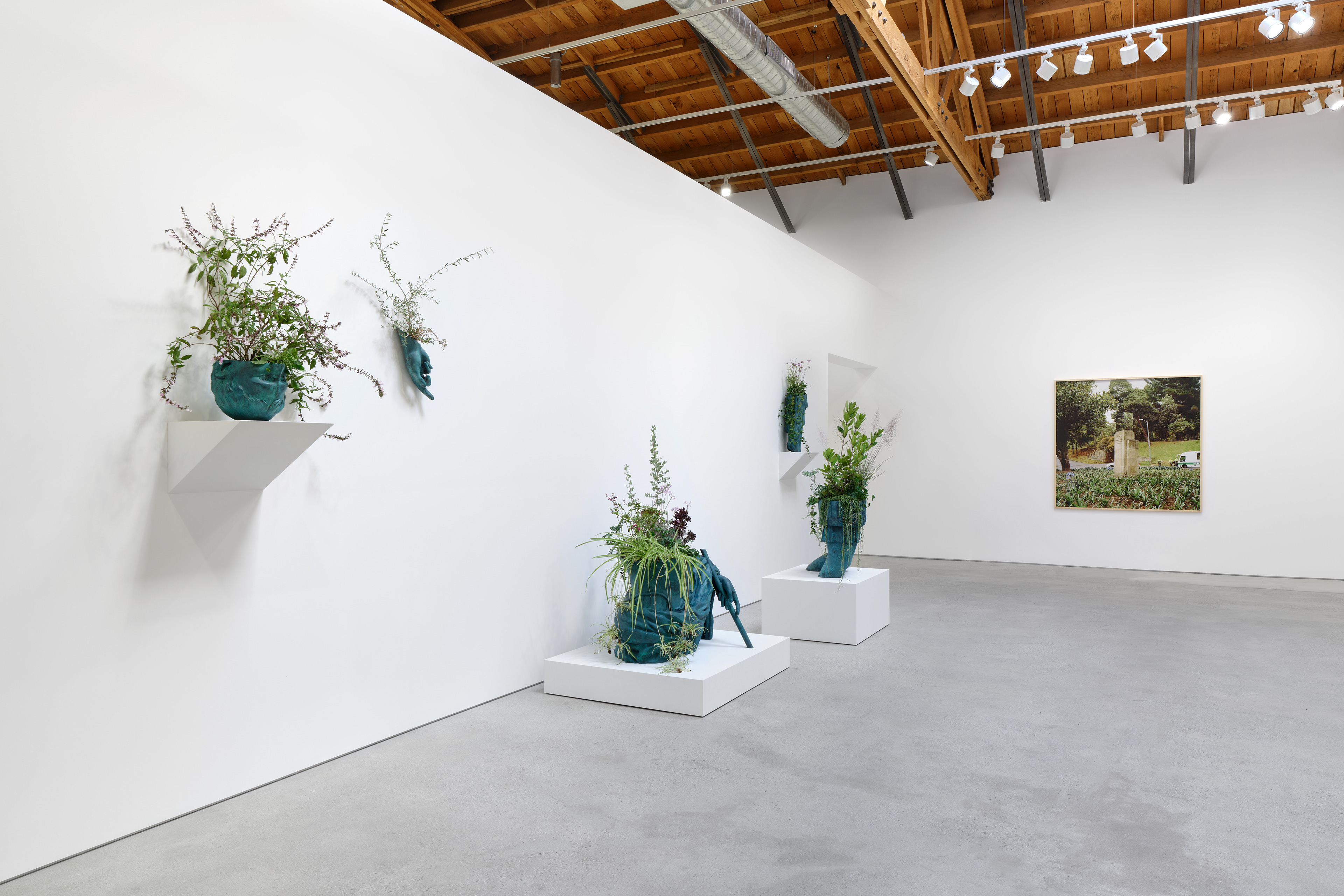The exhibition brings together a tightly-curated selection of the artist’s works made between 2012 and 2024 that critique the notion of public monuments and question the often-contested figures they commemorate. Following on the recent debut of Argote’s High Line Plinth commission in New York, this grouping of works showcases the artist’s humorous yet incisive interventions in which selected monuments are alternately displaced, deconstructed, rendered invisible, or recontextualized. As the title of his exhibition alludes, in Argote’s hands, we are able to consider these public fixtures not as enduring symbols of power and conquest, but as objects that are eminently impermanent.
Perceptive viewers to Perrotin Los Angeles may recognize a familiar locale in Argote’s photograph Turistas: King Charles III of Spain, 2013. One of a series of photos documenting Argote’s simple gesture of dressing a statue with a poncho, the work documents an action the artist undertook in downtown Los Angeles, where a statue of King Charles III of Spain is installed in El Pueblo de Los Angeles State Historic Park. Functioning like a visual form of land acknowledgment ©, Argote’s action uses the typology of Indigenous ponchos to question the legacy of colonial figures while drawing attention to the erasure of Indigenous peoples and lands. In the case of Turistas: King Charles III of Spain, the intervention is especially pointed: El Pueblo de Los Angeles, which commemorates a site where settlers established a community in 1781, bills itself as “The birthplace of Los Angeles”—as if the place did not exist before settlers colonized the region.
Contesting the colonial version of history is also at play in Argote’s Etcetera photographs, 2012–18, for which the artist placed mirrors around a bust in Bogotá, Columbia, of Spaniard Francisco de Orellana, the so-called “discoverer” of the Amazon. With his mirrored construction, Argote temporarily erased the bust’s visual presence while creating a reflection of the monument’s surroundings. In the artist’s words, “I thought of the ridiculousness of this assumption of ‘discoverer’ of all of Amazonia, and then more absurd, to have the country today dedicating
a monument in his honor. There’s no monument in Bogotá that honors the Indigenous communities who now live in the Amazon region, and there is no monument or memorial in honor of the communities who lived there when he passed by, and way before.... That’s why I installed mirrors around him in this action named Etcetera, to see all the rest that is missing instead of him.”
Displayed in dialogue with each other are selections from two bodies of work based on Argote’s research into the Roman Emperor Augustus, who ruled the Roman Empire from 27 BCE to 14 CE. Along the full length of a wall are five sculptures from Argote’s Wildflowers, Augustus series. Here, Argote proposes a dismantling of a bronze version of the famous Augustus of Prima Porta statue, in which Augustus is pictured in a heroic orator’s stance with raised arm, adorned in symbolic garments of classical antiquity. A marble copy of the statue (now located in the Vatican Museums) was discovered in an 1863 archaeological excavation; in Argote’s dismantled version, we see a conceptual proposal to return the statue back to nature by planting these statuary fragments with native plantings. Like the lush biodiversity of the Chernobyl Exclusion Zone, these sculptures speak to the abundance and resilience of the natural world to endure, regenerate, and overcome the ravages of mankind. Augustus also figures in the historical context behind Argote’s Levitate, Villa Medici (Rome), 2024. This large-scale photograph documents one of the most ambitious monumental interventions Argote undertook prior to his 2024 High Line commission. During his time as an artist in residence at the Villa Medici in Rome, Argote built a full-scale replica of the Flaminio Obelisk, one of several obelisks Augustus removed from Egypt and brought back to Rome. Using hired cranes to levitate his obelisk high above Rome, Argote uses an act of physical displacement to perform a cognitive act of making strange.

Iván Argote, Impermanent, Perrotin LA. On view November 2024 – January 2025. Photo by Paul Salveson. Courtesy of the artist and Perrotin.

Iván Argote, Impermanent, Perrotin LA. On view November 2024 – January 2025. Photo by Paul Salveson. Courtesy of the artist and Perrotin.

Iván Argote, Impermanent, Perrotin LA. On view November 2024 – January 2025. Photo by Paul Salveson. Courtesy of the artist and Perrotin.

Iván Argote, Impermanent, Perrotin LA. On view November 2024 – January 2025. Photo by Paul Salveson. Courtesy of the artist and Perrotin.

Iván Argote, Impermanent, Perrotin LA. On view November 2024 – January 2025. Photo by Paul Salveson. Courtesy of the artist and Perrotin.











